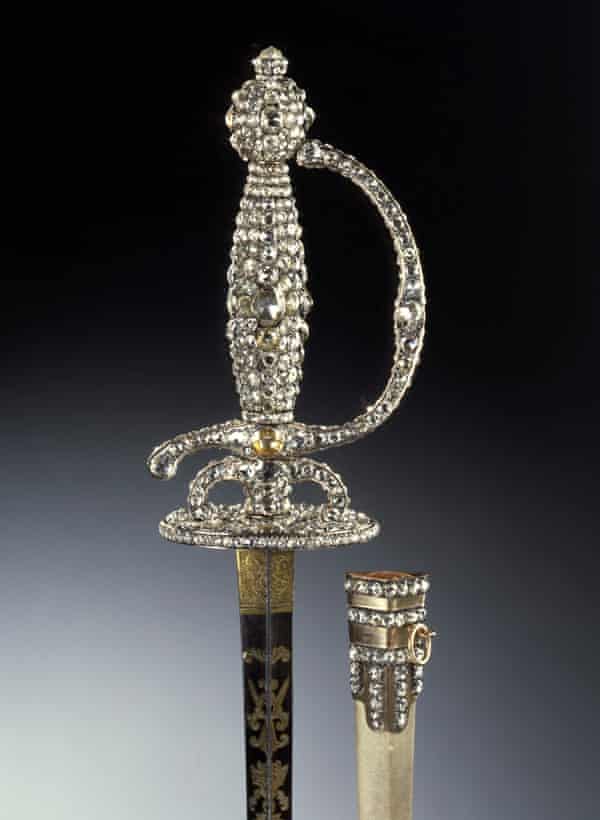The trial of six men accused of stealing 18th-century jewels from a German museum has begun in Dresden amid tight security and questions about whether the treasures will ever be recovered.
The defendants, who are brothers and cousins aged between 23 and 28, appeared in court in handcuffs and holding large folders in front of their faces. They had slung jackets over their heads to avoid being photographed.
Proceedings are being held in Dresden’s district court, where the men appeared behind tall safety glass.

In accordance with German judicial practice, they have been referred to only by the initial of their family name, R. Media reports, however, have identified them as part of a Berlin clan consisting of 10 families and more than 1,000 members that has been held. responsible for other high-level heists in recent years.
The men are accused of aggravated gang theft and serious arson, according to Dresden’s public prosecutor’s office. The robbery took place in November 2019 when masked men broke into the city’s Grünes Gewölbe, or Green Vault, and stole 21 items of jewelery containing more than 4,300 diamonds and valued at just under €114m (£95m).
In what appears to have been a carefully choreographed heist, the planning for which began in the previous summer, the robbers first set light to a circuit-breaker panel, plunging the street lighting around the palace housing the museum into darkness.
In the early hours of the morning of 25 November, several people then entered the elaborate marble and mirror-clad room housing the jewels and smashed a glass cabinet with an ax 56 times in less than 30 seconds before leaning over the splinters to seize the items with fishing twine. The items included an epaulette, a rapier, two shoe buckles, a hat pin, brooches, a gem from the Polish Order of the White Eagle, a large diamond rose and several skirt buttons.

The robbers used fire extinguisher foam to cover their tracks and made off quickly in their Audi getaway car. It is thought the entire robbery took about 10 minutes. The Audi was set on fire in an underground car park before the men drove in a Mercedes disguised as a taxi back to Berlin.
Two of the suspects on trial have already been sentenced to four and a half years in prison for their involvement in stealing the Big Maple Leaf, a 100kg gold coin worth €3.7m from Berlin’s Bode Museum in 2017.
The accused were seized after a year-long investigation by 40 officers, which included a series of raids involving hundreds more police who arrested three of the men in November 2020 and the other three in the following months.
The stolen items were acquired in the 18th century by Augustus the Strong, the elector of Saxony and later king of Poland, who had a fierce rivalry with France’s King Louis XIV which extended to their collections of precious jewels.
The jewels survived Allied bombing raids during the second world war but were subsequently removed by Red Army soldiers and seized as war booty. They were returned to Dresden in 1958.
Authorities initially offered reward of €500,000 to anyone who would lead police to the jewelery’s whereabouts. That has since been raised to €1.5m after a private initiative to collect donations.
The defendants have so far refused to answer questions.
The head of the Dresden art collections, Marion Ackermann, has said she reviewed security measures at her museums after the coin robbery at the Bode, where serious security breaches including a faulty alarm system and a broken window were discovered to have facilitated the theft.
The Dresden robbers, however, still managed to prepare for their heist unnoticed a week beforehand by using a hydraulic bolt cutter to slice a hole in a grate window that they then glued together again to disguise the break. On the night of the crime, a scanner that creates invisible barriers that trigger an alarm was switched off, though how this occurred is unclear. The robbers’ presence in the building was only noticed when they appeared on security cameras, but it was considered too dangerous to apprehend them and they had escaped before police arrived.
Among the questions it is hoped the trial will answer is whether the robbers had help from insiders at the museum. Evidence suggests they were aware of parts of the museum that security cameras were unable to detect.
Ackermann said before the trial that she lived in hope that the items had not been broken up for the sale of the individual diamonds and was optimistic that publicity surrounding the trial would raise awareness of them among people in the trade who might be invited to buy them .
The Green Vault’s director, Marius Winzeler, told German media: “We will not rest until we have the jewels back.”
The trial, involving 14 defense lawyers from across Germany, three prosecutors and representatives of the juvenile court because of the age of two of the defendants, twin brothers, at the time of the crime, is expected to continue at least until the end of October .
Prosecutors are separately continuing to investigate 40 further people in relation to the heist, including four men who are suspected of entering the museum disguised as tourists to gather strategic information about its security, layout and personnel movements.
www.theguardian.com
George is Digismak’s reported cum editor with 13 years of experience in Journalism